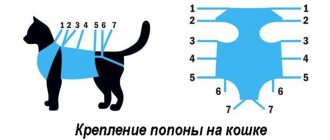Castration of a cat involves the surgical removal of paired sex glands - testes, which secrete testosterone and in which sperm are formed. The operation is performed under anesthesia, during which the surgeon dissects the scrotum and cuts out the testes and appendages.
The essence of cat castration
Castration of a cat is the removal of the testes. Sterilization only blocks their channels. Sperm cannot be released naturally, being destroyed in the testicles and the accessible part of the canals. Protein is utilized by phagocytes - blood cells that capture and utilize what is not needed.
Sterilization preserves hormonal levels, in particular testosterone production. Therefore, the cat’s character does not change; attraction to the opposite sex, activity, and male aggressiveness remain.
behaves differently after castration With the blocking of testosterone production, the animal becomes un-manly, docile, calm, and does not show interest in cats.
There are three methods of castration. The first one is open. The scrotum and the common tunica vaginalis, which covers the testis and has access to the abdominal cavity through the vaginal canal, are cut. The testicle itself is removed.
In this case, the vaginal ligament near the appendage is cut. The ligament is fibrous and connects the inner and outer layers of the scrotum. Cutting the ligament allows the spermatic cord to open as much as possible. At the top point a ligature is placed - a dressing thread.
The cord below it is cut off at a centimeter distance. The tail of the epididymis in the tunica vaginalis is also cut. The steps are repeated on the second half of the scrotum and the wounds are sprinkled with an antiseptic. Sutures are not required during castration.
The second method is closed. The essence of castrating a cat in this case comes down to cutting only the scrotum. The vaginal membrane underneath is twisted 180 degrees, stitched and tied with a ligature at the top point.
Essentially, we are talking about sterilization. The testicles are preserved. But the exit to the abdominal cavity is blocked. It is necessary to block it for cats with enlarged inguinal openings. They are increased in the elderly and individuals with hernias.
A separate discussion is the castration of cryptorchids. In such cats, the testes or one of them are retained in the body cavity or inguinal canal. The anomaly leads to increased aggression and increased sexual desire. During the operation, the skin is incised obliquely in the area of the inguinal ring.
A five-centimeter incision is usually sufficient to remove the testes. In this case, you need to pull back the inguinal arteries and push apart the subcutaneous fat with your hands. The testis is felt with your hands and stretched out as much as possible. A ligature is placed on his appendage as high as possible. A cut is made below.
Surgeons take into account that when cutting the seminiferous tubules, cats involuntarily urinate. The jet may hit the doctor's face. It is also important to consider the type of surgery. So, when castrating bilateral cryptorchids, they are placed on their backs, fixing their paws.
General anesthesia is required. If the cryptorchid is unilateral, it is placed on its side with the testis correctly positioned. Castration time for cats is 20-30 minutes.
What are the types and methods of cat sterilization operations?
It is generally accepted that male cats are castrated and female cats are sterilized. In fact, this is a little different. In cats, both castration and sterilization are possible. But to avoid confusion in communicating with patients, doctors use generally accepted terminology - for cats only sterilization. Classical sterilization involves removing only the ovaries, while preserving the uterus. The cat loses the ability to become pregnant, while she is left with a healthy but functionally useless organ, which, like any other, can get sick. Preservation of the uterus in a sterilized cat is fraught with pyometra, endometritis, benign or malignant formations. In castration, all reproductive organs are removed. Classical sterilization is performed quite rarely today; castration surgery is preferable in all respects. However, the procedure itself continues to be called sterilization out of habit. There are 4 types of cat sterilization:
- removal of ovaries;
- uterus removal;
- tubal ligation;
- removal of both the uterus and ovaries (castration);
Today in veterinary medicine only one type is actively used - castration, because all others either harm the animal or do not give the desired effect. What's the point of removing a cat's uterus but leaving the hormone-producing ovaries? The cat will not be able to get pregnant, but will “walk.” Tubal ligation also preserves the reproductive instinct, and the cat's reproductive system is so strong that the tubes grow back and pregnancy occurs.
Sterilization methods
Sterilization surgery is carried out using different methods, all of which have their own disadvantages and advantages. The differences mainly relate to the size and position of the incision. A large incision allows for faster and complete removal of the necessary organs, but may leave a noticeable scar. Small incisions heal quickly and easily, but are somewhat limiting for the surgeon. Sometimes the uterus cannot be completely removed.
The most common methods:
- classical;
- through a side incision;
- through an ultra-small incision;
- laparoscopic.
How long does it take to sterilize cats?
If the animal is properly prepared, the procedure takes from 15 to 45 minutes. Owners should not watch how cats are sterilized; trust your pet in the safe hands of a veterinarian and wait outside the door. Soon you will be caring for her during her rehabilitation period.
Sterilization at home
For some cats, leaving the house is a huge stress, which the animal experiences more difficult and difficult than medical procedures. A veterinarian is usually invited to visit such pets at home. This can also be done for sterilization. The procedure itself is not complicated, so if necessary, it can be done at home. But still, this is the exception, not the rule, and if there is even a slight possibility, then sterilization should be carried out in a clinic. The operation at home can only be performed by a qualified and practicing veterinarian; the animal must be examined and completely healthy.
Is there an alternative to sterilization? No other method of contraception will give the same effect. Hormonal drugs that are given during the onset of estrus have negative consequences and can provoke the development of serious diseases. Not all animals respond to them adequately. As an option, you can use a hormonal implant, which is valid for 3 years. The implant is inserted under the skin and suppresses the reproductive instinct for a limited period. Suitable for those cases when you need to temporarily limit the cat's reproductive function, for example, you want kittens, but not now. There are also long-acting hormonal injections. In general, this is the same hormone therapy, but with different sauces. At the same time, feline contraception relieves the violent manifestation of estrus, but does not protect against pregnancy, especially when keeping a cat together with a male cat.
Preparing for surgery
For sterilization, as for any other surgical operation, the animal must be prepared. The cat eats its last meal in the evening, so that at least 10-12 hours pass before surgery. The pet is limited to water in the morning, 3-4 hours before the start of the procedure. If there are remains of food and water in the stomach, then anesthesia will provoke nausea and vomiting. Vomiting during surgery is fraught with suffocation and the development of aspiration pneumonia. Also, a cat to be sterilized must be vaccinated a month before surgery. Otherwise, she may catch an infection in the clinic, which will complicate rehabilitation. If there has been no vaccination, then serum globulins are administered, but they do not provide the same protection as the vaccine.
Anesthesia
Many people are shocked that cats' eyes remain open under anesthesia. It looks creepy, but that's physiology. To prevent the cornea from drying out during the operation and after, until the anesthesia completely wears off, the eyes are moistened with “Artificial tear” drops. You can also use regular saline solution, or blink for the cat once every five minutes - close and open its eyelids several times so that tears flow.
Caring for a cat after sterilization
Where to place the cat after surgery? After sterilization, you can leave the cat at the clinic for a day hospital. She will be under the supervision of staff until she fully recovers from anesthesia. Most owners prefer to take their pets home, to a familiar and familiar environment. Prepare a dark and quiet place for your cat. Bright light irritates the eyes after anesthesia, and the cornea can be dehydrated and sore. Place the bedding on the floor. Often cats, while still intoxicated, try to crawl or go to the tray or bowl. You can fall from a bed or chair and get injured.
How to feed a cat after sterilization?
A healthy cat gets back on its feet 12-24 hours after surgery. Normally, she can refuse food for up to three days. You should make sure your cat is getting enough fluids, as dehydration is worse than a hunger strike. Offer your pet food several times a day. If her behavior remains strange or she looks sick, contact your veterinarian immediately. Caring for sutures In modern veterinary medicine, very high-quality suture material is used. Sutures may be placed with absorbable sutures or will need to be removed after 7-10 days. After the operation, the sutures are treated with special agents to prevent infection. The cat is also given a protective blanket, which it wears until it is fully recovered. That is, caring for seams is quite simple:
- observe hygiene standards;
- do not wet;
- do not let the cat scratch them;
- limit your favorite in jumping and complex acrobatic sketches;
- Make sure there is no redness or pus.
If you suspect inflammation, you should consult a doctor. You may not be able to determine on your own how serious it is.
At what age should a cat be castrated?
At what age a cat should be castrated depends on his anatomy. So, temporary cryptorchidism is possible. Before the age of one year, the testes may descend. However, in the 2nd year of a cryptorchid cat’s life, the question of castration arises.
If the testes have the correct physiological location and the decision is made to castrate, the operation is recommended to be performed at 7-9 months. The lower limit is the beginning of puberty. By the 11th month it is usually completed.
If you operate on a kitten, there is a high risk of complications. They affect the urinary system. Adhesions form in its channels. They block the ureter. The process is triggered by inflammation that accompanies the recovery period after castration.
Meanwhile, young cats have narrow urinary canals. Inflammation, which adult animals tolerate easily, kittens endure with serious consequences.
Castration of a cat after 9 months of age is fraught not so much with health problems as with unwanted intercourse with females, fights for territory with individuals of the same sex.
How to prepare a cat for castration
Before castration, the cat is examined. The health of the genitourinary system and heart is especially carefully checked. The latter is examined, taking into account the operation under general anesthesia. With pathology of the heart muscle, complications, including death, are possible.
Treatment of the cat against helminths and external treatment against parasites is mandatory. They are carried out 10 days before castration. If the previous anthelmintic treatment was carried out a month or less before surgery, repeat treatment is not required.
Before the operation, the availability of routine vaccinations is checked. It should be a month or more since the last vaccination.
For cats without vaccinations, a special serum is provided. It is complex and ensures the development of immunity within 2 weeks.
12 hours before the operation, the cat is no longer allowed to eat and water is kept to a minimum. Anesthesia provokes the urge to vomit. To prevent asphyxia, that is, suffocation with vomit, the stomach and intestines must be emptied.
Owners need to prepare a cat’s veterinary passport with vaccination records, a blanket, a carrier with a folding top, a disposable diaper as bedding for the carrier, and napkins. This kit is taken for surgery. Napkins are needed in case of vomiting.
Preparation
Before the operation, the cat is examined at the clinic.
Step-by-step instructions on how to prepare a cat for castration:
- Visit the veterinarian for a full examination . The specialist examines the animal, assesses the degree of its development and readiness for removal of the reproductive organs. The cardiologist then determines your breathing rate and pulse.
- Prescribing the necessary tests to exclude existing pathologies . The standard set includes blood and urine tests, tests to identify parasites (worms, fleas) in the body. Their presence suppresses the immune system, which can lead to serious complications after surgery.
- Carrying out routine vaccination . The cat may have recently been vaccinated. Then you will have to wait at least 2 weeks. If the clinical picture is stable, surgery is prescribed. It is better not to have any vaccinations 2 months before the procedure.
You should not feed for half a day before castration and do not give anything to drink for about 3 hours. Otherwise, he may vomit.
Care after castration
After castration of a cat , anesthesia wears off when the animal is on its way home, or is already at home. The process is unpredictable and partly depends on preoperative preparation, the accuracy of the dosage of the narcotic drug and the individual reaction of the animal to it.
Possible violence when recovering from anesthesia. Therefore, you need a spacious carrier with a closing top. It is prohibited to transport a cat in your arms or in a car seat.
During transportation and until recovery from anesthesia, the cat should lie on its side. In order to avoid the difficult transportation of a pet, some people order castration of a cat at home .
Under the influence of anesthesia, an animal cannot regulate its body temperature. Therefore, caring for a cat after castration involves providing warmth. The first day after surgery, the pet is wrapped in a warm blanket and placed on a heating pad or a bottle filled with warm water. They are placed near the cat's back.
It is necessary to avoid heating the perineum. This may cause inflammation or bleeding. Taking this into account, the carrier should not be placed next to a radiator or fireplace. Drafts also need to be excluded.
The carrier, or sleeping place, where the cat moves at home should be near the floor. An animal that is not yet fully adequate after anesthesia may fall from a height.
During narcotic sleep, cats do not close their eyelids. This leads to drying out of the cornea and, as a result, its inflammation. The process needs to be prevented. It is enough to close your pet’s eyelids every half hour and gently massage over the eyeballs.
It’s not just the cat’s eyes that are dry from anesthesia. Dehydration affects the entire body. This leads to thirst. As soon as the cat gets stronger and gets on its feet, it is important to give it clean water. It is advisable that the bowl with it stand close to the carrier.
Cats are fed at least 20 hours after castration. By this time, most animals have time to get stronger and show interest in food. It cannot be given by force. If the cat asks for food, he is offered meat broth, kefir or cottage cheese.
For the first 10 days after surgery, the cat is given the usual foods. Afterwards, the transition to a special diet for castrated animals is smoothly carried out. Dry food is produced for them.
The minimum time for a cat to recover from anesthesia is 2 hours, and the maximum is 24 hours. At this time, the cat often marks after castration . Urination is involuntary. You shouldn't punish an animal. After a few days, the pet will again be able to control urination.
It is allowed to bathe a cat approximately 2 weeks after castration. By this time, the wounds are healing. If cleaning is required before, use dry shampoo or wet wipes. It is worth stocking up on a special collar.
This is in case the cat actively licks its wounds. A rough tongue can interfere with their healing. The collar is sold in veterinary pharmacies and pet stores. Some cats wear collars for 7 days. Other pets don't show much interest in post-surgical wounds. Then the collar is not worn.
Coming out of anesthesia
After the operation, it takes about 2 days to fully recover from anesthesia. During this period, the animal does not eat anything due to nausea. It especially needs careful handling and affection. Therefore, it is recommended not to leave him in the clinic, although some institutions offer a paid service to quickly recover the cat from anesthesia.
At home, the pet is placed on a soft bed sideways, covered with something warm (it gets chilly). You can give him something to drink 4-5 hours after the procedure.
After anesthesia
Pros and cons of castration
The pros and cons of castrating a cat is a list that differs from the point of view of scientists and ordinary people. Veterinarians see only positive things in the operation. Neutered cats live 1.5-2 years longer than usual, do not mark their territory and do not show aggression.
Animals stop meowing at night and become as obedient as possible. You can forget about prostate adenoma and sexually transmitted infections. They do not threaten a castrated cat. Tumor processes after surgery are also unlikely, especially if the intervention was performed on a young pet.
Cat owners also find downsides to castration, noting that many animals become obese. This is due to the laziness of those who underwent surgery. Leading a sedentary lifestyle and not being interested in the opposite sex, people with mustaches find solace in food.
However, obesity is the result of an incorrectly selected diet and diet, veterinarians note.
Doctors admit only one objective disadvantage of castration - an increased risk of developing urolithiasis. Systematic surveys are required in this regard.
Price of the procedure
The price of castration of a cat ranges from 1-7 thousand rubles. The minimum is requested by standard budget clinics, and the maximum by private clinics.
A visit from a surgeon to your home is approximately 30% more expensive than an operation in a medical institution. The price partly depends on the region and the condition of the cat. Operating on cryptorchid, for example, is more difficult.
Castration is a simple operation. For comparison, the minimum price tag for sterilization is 3 thousand rubles. The request is due to the duration of the intervention, its complexity, and the cost of medications











